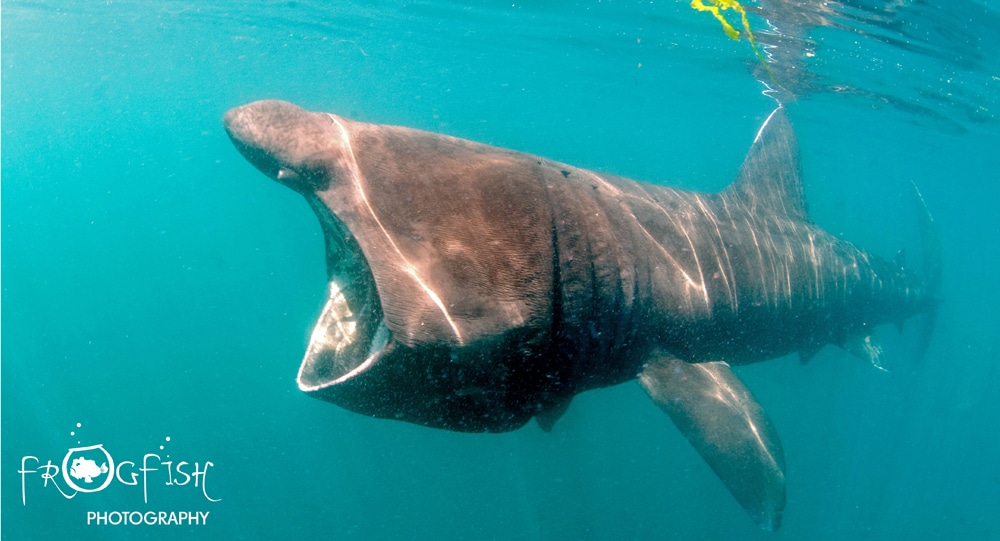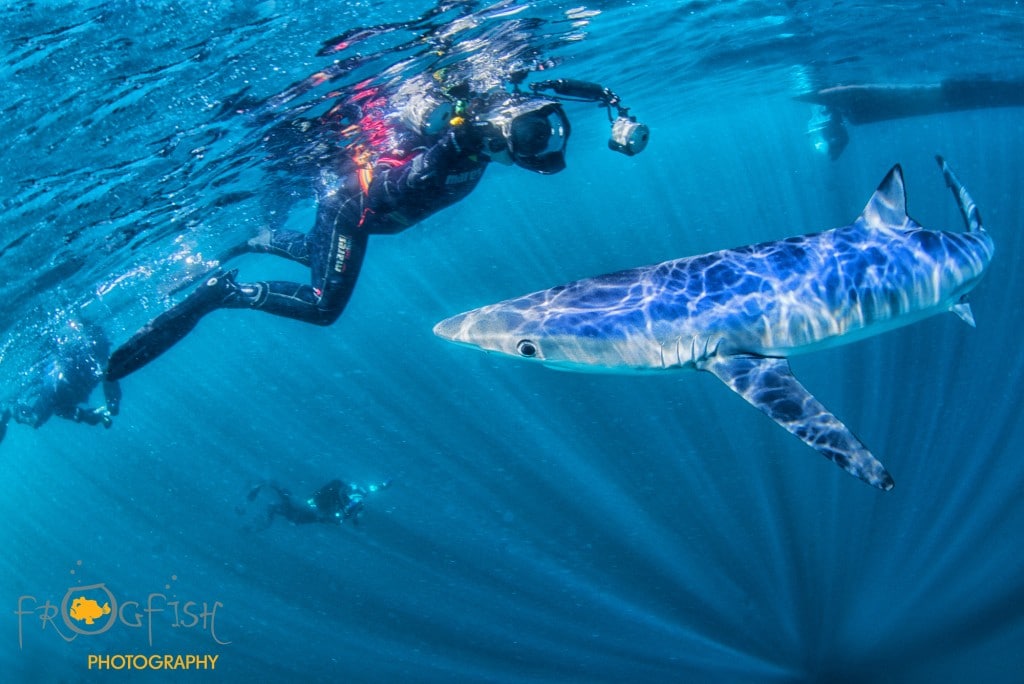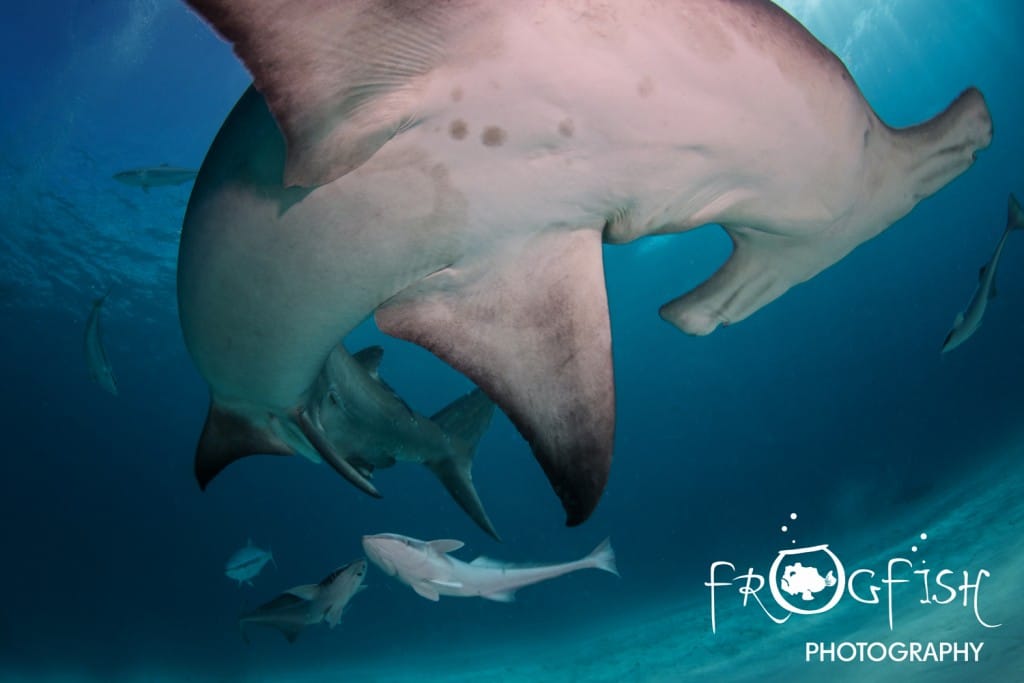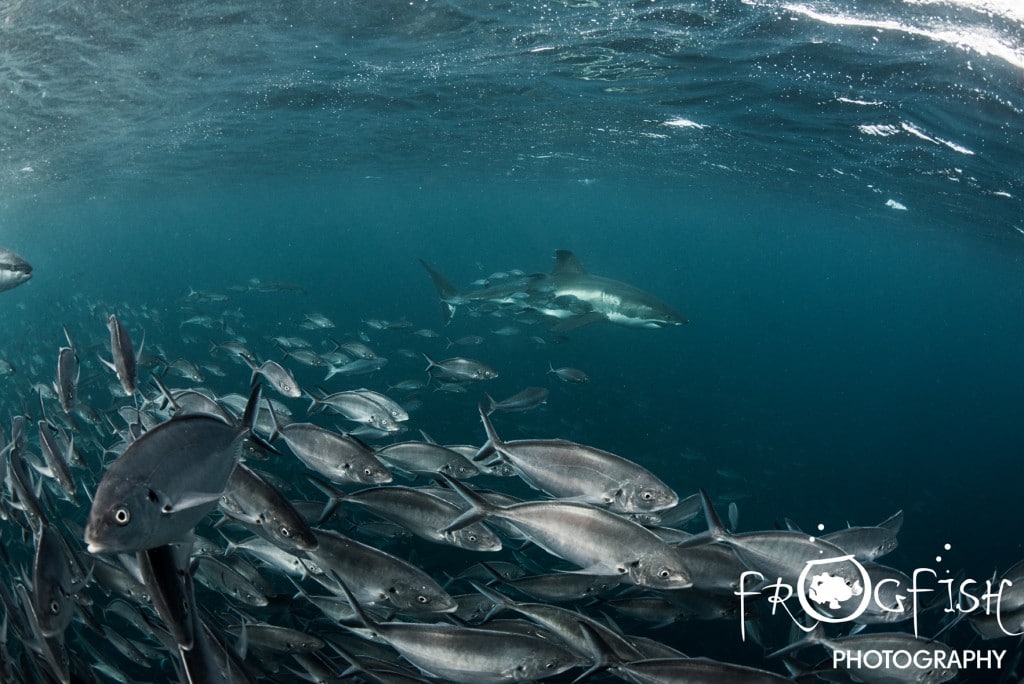Marine Life & Conservation Blogs
Photo Gallery: Shark Week

It is Shark Week this week and so to celebrate these wonderful creatures, our gallery features images from some of our favourite shark dives around the world. The mainstream press don’t do these much misunderstood predators any favours, often portraying them as mindless killers, when in truth, they live complex lives and have amazing adaptations to their environment.

Image 1: This shot is from our very first shark dive, which was at Aliwal Shoal in South Africa. It was a defining couple of dives for us and really was the catalyst for all our shark diving images that followed. This pair are Blacktip Sharks and part of a group of around 30 sharks that joined us for this dive. On our trip back to shore we also saw our first ever Whaleshark – it was quite a day! Dive Operator: www.bluewilderness.co.za

Image 2: Caribbean Reef Sharks swimming over a healthy reef off Nassau in The Bahamas. We were the only people on this dive and had between 6 and 10 sharks around us for over an hour. We spent a couple of days diving with Caribbean Reef Sharks on reef and wrecks in clear, blue, warm shallow waters. It was heaven! Dive Operator: www.stuartcove.com

Image 3: After a wonderful trip to Socorro, it was a bit of an impulsive decision to head out to try to find Blue, Mako or Smooth Hammerhead Sharks off the Cabo coastline in Mexico. We were flying home the next day, so could not dive, and this was the perfect way to end a wonderful trip. We spent time snorkelling with two Smooth Hammerhead Sharks, a first for us, and their curious nature meant that we had some lovely close encounters.
Dive Operator: www.cabosharkdive.com

Image 4: Blue Sharks are one of the most beautiful sharks you can encounter and they are found in plenty of places around the world. Our encounter with them was close to home, in Cornwall in the UK. Whilst we only saw one individual, she stayed with us for over an hour, and with only 5 people on the dive boat, there were plenty of great photographic opportunities. Dive Operator: www.charleshood.com

Image 5: One of our all-time favourite dives has got to be the Great Hammerhead dive in Bimini in The Bahamas. Seeing these amazing, and huge, sharks up close is a real treat. We have done this dive on two different visits and cannot wait to go back! The dive is in shallow water and there is usually plenty of sunlight shining down. This image shows the incredible turning circle the Great Hammerhead has, as it swam right over our heads. Dive Operator: www.biminiscubacenter.com

Image 6: You can never rely on the weather, especially when you are heading out to small remote islands a good distance from land. Alas, we were unlucky on our Great White Shark expedition in South Australia, with a polar vortex coinciding with our trip, but even with tough photographic conditions, we had an amazing time. The Great White Shark is an awesome beast, and even though you know they are going to be big – their sheer size still surprises you. Dive Operator: www.rodneyfox.com.au

Image 7: A Basking Shark from Cornwall, UK feeds with its mouth wide open to take in as much plankton as possible. These huge sharks, this one was about 7 meters in length, come to the west coast of the UK from Cornwall to Scotland in early summer to feed. The plankton they feed on can vastly reduce the visibility and therefore photography can be challenging. To get the best shots, watch their feeding behaviour for a while to make an educated guess as to their pattern, before you get in the water and then wait for them to come to you. Dive Operator: www.charleshood.com
There are so many more we could have added to this gallery! We will have to leave it there for now, but will be returning to our favourite shark dives and writing some more about this topic soon.
For more from Nick and Caroline, visit www.frogfishphotography.com
Marine Life & Conservation Blogs
Creature Feature: Dusky Shark

 In this series, the Shark Trust will be sharing amazing facts about different species of sharks and what you can do to help protect them.
In this series, the Shark Trust will be sharing amazing facts about different species of sharks and what you can do to help protect them.
This month we’re taking a look at the Dusky Shark, a highly migratory species with a particularly slow growth rate and late age at maturity.
Dusky sharks are one of the largest species within the Carcharhinus genus, generally measuring 3 metres total length but able to reach up to 4.2 metres. They are grey to grey-brown on their dorsal side and their fins usually have dusky margins, with the darkest tips on the caudal fin.
Dusky Sharks can often be confused with other species of the Carcharhinus genus, particularly the Galapagos Shark (Carcharhinus galapagensis). They have very similar external morphology, so it can be easier to ID to species level by taking location into account as the two species occupy very different ecological niches – Galapagos Sharks prefer offshore seamounts and islets, whilst duskies prefer continental margins.
Hybridisation:
A 2019 study found that Dusky Sharks are hybridising with Galapagos Sharks on the Eastern Tropical Pacific (Pazmiño et al., 2019). Hybridisation is when an animal breeds with an individual of another species to produce offspring (a hybrid). Hybrids are often infertile, but this study found that the hybrids were able to produce second generation hybrids!
Long distance swimmers:
Dusky sharks are highly mobile species, undertaking long migrations to stay in warm waters throughout the winter. In the Northern Hemisphere, they head towards the poles in the summer and return southwards towards the equator in winter. The longest distance recorded was 2000 nautical miles!
Very slow to mature and reproduce:
The Dusky Shark are both targeted and caught as bycatch globally. We already know that elasmobranchs are inherently slow reproducers which means that they are heavily impacted by overfishing; it takes them so long to recover that they cannot keep up with the rate at which they are being fished. Dusky Sharks are particularly slow to reproduce – females are only ready to start breeding at roughly 20 years old, their gestation periods can last up to 22 months, and they only give birth every two to three years. This makes duskies one of the most vulnerable of all shark species.
The Dusky Shark is now listed on Appendix II of the Convention on the Conservation of Migratory Species (CMS), but further action is required to protect this important species.
Scientific Name: Carcharhinus obscurus
Family: Carcharhinidae
Maximum Size: 420cm (Total Length)
Diet: Bony fishes, cephalopods, can also eat crustaceans, and small sharks, skates and rays
Distribution: Patchy distribution in tropical and warm temperate seas; Atlantic, Indo-Pacific and Mediterranean.
Habitat: Ranges from inshore waters out to the edge of the continental shelf.
Conservation status: Endangered.
For more great shark information and conservation visit the Shark Trust Website
Images: Andy Murch
Diana A. Pazmiño, Lynne van Herderden, Colin A. Simpfendorfer, Claudia Junge, Stephen C. Donnellan, E. Mauricio Hoyos-Padilla, Clinton A.J. Duffy, Charlie Huveneers, Bronwyn M. Gillanders, Paul A. Butcher, Gregory E. Maes. (2019). Introgressive hybridisation between two widespread sharks in the east Pacific region, Molecular Phylogenetics and Evolution 136(119-127), https://doi.org/10.1016/j.ympev.2019.04.013.
Marine Life & Conservation Blogs
Creature Feature: Undulate Ray

 In this series, the Shark Trust will be sharing amazing facts about different species of sharks and what you can do to help protect them.
In this series, the Shark Trust will be sharing amazing facts about different species of sharks and what you can do to help protect them.
This month we’re looking at the Undulate Ray. Easily identified by its beautiful, ornate pattern, the Undulate Ray gets its name from the undulating patterns of lines and spots on its dorsal side.
This skate is usually found on sandy or muddy sea floors, down to about 200 m deep, although it is more commonly found shallower. They can grow up to 90 cm total length. Depending on the size of the individual, their diet can range from shrimps to crabs.
Although sometimes called the Undulate Ray, this is actually a species of skate, meaning that, as all true skates do, they lay eggs. The eggs are contained in keratin eggcases – the same material that our hair and nails are made up of! These eggcases are also commonly called mermaid’s purses and can be found washed up on beaches all around the UK. If you find one, be sure to take a picture and upload your find to the Great Eggcase Hunt – the Shark Trust’s flagship citizen science project.
It is worth noting that on the south coasts, these eggcases can be confused with those of the Spotted Ray, especially as they look very similar and the ranges overlap, so we sometimes informally refer to them as ‘Spundulates’.
Scientific Name: Raja undulata
Family: Rajidae
Maximum Size: 90cm (total length)
Diet: shrimps and crabs
Distribution: found around the eastern Atlantic and in the Mediterranean Sea.
Habitat: shelf waters down to 200m deep.
Conservation Status : As a commercially exploited species, the Undulate Ray is a recovering species in some areas. The good thing is that they have some of the most comprehensive management measures of almost any elasmobranch species, with both minimum and maximum landing sizes as well as a closed season. Additionally, targeting is entirely prohibited in some areas. They are also often caught as bycatch in various fisheries – in some areas they can be landed whilst in others they must be discarded.
IUCN Red List Status: Endangered
For more great shark information and conservation visit the Shark Trust Website
Image Credits: Banner – Sheila Openshaw; Illustration – Marc Dando
-

 News3 months ago
News3 months agoHone your underwater photography skills with Alphamarine Photography at Red Sea Diving Safari in March
-

 News3 months ago
News3 months agoCapturing Critters in Lembeh Underwater Photography Workshop 2024: Event Roundup
-

 Marine Life & Conservation Blogs2 months ago
Marine Life & Conservation Blogs2 months agoCreature Feature: Swell Sharks
-

 Blogs2 months ago
Blogs2 months agoMurex Resorts: Passport to Paradise!
-

 Blogs2 months ago
Blogs2 months agoDiver Discovering Whale Skeletons Beneath Ice Judged World’s Best Underwater Photograph
-

 Marine Life & Conservation2 months ago
Marine Life & Conservation2 months agoSave the Manatee Club launches brand new webcams at Silver Springs State Park, Florida
-

 Gear Reviews3 months ago
Gear Reviews3 months agoGear Review: Oceanic+ Dive Housing for iPhone
-

 Gear Reviews2 weeks ago
Gear Reviews2 weeks agoGEAR REVIEW – Revolutionising Diving Comfort: The Sharkskin T2 Chillproof Suit






















